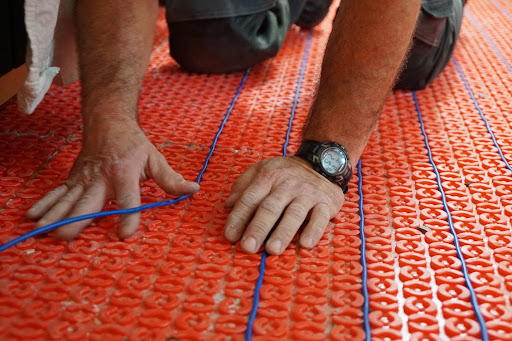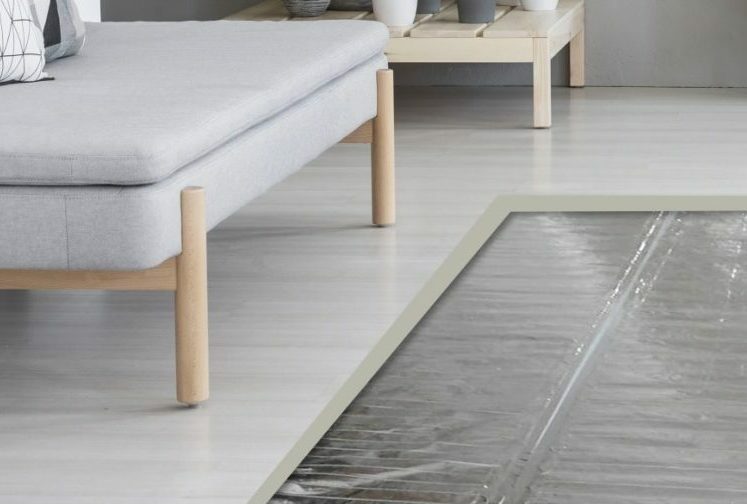With quick heat-up times, ease of installation and energy-saving technology, Warmup’s radiant floor heating systems are an increasingly popular way to bring warmth to contemporary homes. So, if you’re wondering whether underfloor heating is right for you, in this guide we’ll explore everything you need to know. You’ll discover:
- How radiant heating systems function to provide energy-saving warmth
- The benefits of Warmup floor heating systems
- How simple it is to install floor heating
- The best Warmup heating solutions for every room of your home
- How much radiant heating costs
What is Radiant Floor Heating? How does it Work?
Radiant flooring is a form of heating that involves installing a network of either water tubes or electric heating cables under the floor’s surface. Whereas traditional heating systems require air ducts and vents to simply warm the air of the space, a floor heating system uses radiant heat technology to warm the people and objects in the space directly, from the ground-up. This process is much more energy-efficient, making you feel more comfortable, more quickly with lower running costs. Traditional heating systems also present another common household problem: inconsistent heating. The location of the vents determines where the heat will produce – leading to some areas of your home being warmer than others. Underfloor heating distributes heat through the entire floor, creating an evenly heated room with no cold drafts.
Types of In-Floor Heating Systems
When considering radiant heat flooring systems, there are two primary types: electronic and hydronic.
- Hydronic heated floor systems: These systems utilize a network of pipes installed under the floor which distribute heated water. Due to their more labor-intensive installation requirements and upfront costs, hydronic underfloor heating systems are best for new constructions.
- Electric heated floor systems: These systems use electric heating cables or mats to provide 100% efficient direct electric heat. Unlike hydronic systems, electric radiant heat systems are very easy to install and offer lower upfront costs too. Warmup offer a wide range of electric floor heaters that provide cleaner, more sustainable warmth for any room of a home.
Why Install an Underfloor Heating System?
Installing an radiant heating system is one of the smartest ways to improve both the comfort and energy efficiency of your home. Unlike traditional systems that heat the air unevenly and require bulky equipment, radiant floor heating delivers warmth precisely where it’s needed—from the ground up. This results in faster, more consistent heat that doesn’t dry out the air or stir up dust. Whether you’re renovating a single room or building a new home, underfloor heating offers a sleek, low-maintenance, and cost-effective solution that enhances both your lifestyle and your property’s value.
Electric Heated Floors from Warmup
Founded over 25 years ago, Warmup is a UK-based manufacturing PLC dedicated to creating innovative smart controls and radiant heating solutions. They focus on electric heating systems that offer solutions for every project, room, and floor type.
The DCM-PRO is one option that combines the DCM-PRO Heating Cable and Membrane with the 6iE Smart WiFi Thermostat. It is the only UL-approved Membrane System in North America and offers the highest heating outputs, making it one of the best floor heating systems Warmup offers.
The Warmup Foil system is ideal for carpet, laminate, engineered wood, and other floating floor options. It doesn’t require any self-leveling and is thin enough that it won’t bring your floors higher. The In-Slab Cable system is designed for installation in concrete slabs between 2″ to 4″ thick.
They offer heating systems for driveways that melt snow and ice, keeping driveways oriented from winter weather. These systems work with concrete, asphalt, and even pavers.
Sounds interesting? These are just some of the products offered. Check out our website for everything else we offer.

The Top 6 Benefits of a Heated Floor System
Underfloor radiant heating systems offer many benefits. Here are some of the top reasons to consider installing a system in your home.
1. Floor heating systems go unseen
The big problem with most heating options like HVAC systems, space heaters and radiators, is that they take up valuable space. A heated floor system offers a discreet option that doesn’t take up space or disrupt the room’s aesthetics. With these systems, you won’t have to worry about planning your interior around radiators or air registers, which gives you more much more design freedom.
2. Energy-efficient and cost-effective
Radiant heat flooring is cost-effective and much more energy-efficient than traditional options. Radiators, for example, have to be heated to around 167ºF before heating up a room, and duct-based systems almost always suffer some heat loss. This will make the systems work harder to compensate for the loss, increasing energy consumption and costing homeowners more. With in-floor heating, the floors are heated directly, which allows heat to radiate upwards and evenly across a room while significantly reducing heat loss. As a result, a radiant floor system can help homeowners save money on their heating costs.
3. Smart thermostat compatibility
All floor heating systems require use of a system-dedicated thermostat. Warmup’s collection of Smart thermostats allow you to program your heated floor system with ease or enjoy the comfort of automatic heating; ensuring consistent temperatures whether you are in or away from your home. Warmup Smart controls are also compatible with other Smart home devices such as the Creston and Control 4 building management systems as well as the Amazon Alexa and Google Home Smart speakers.
4. Maintenance-free
Electric in-floor radiant heat systems require there no maintenance or servicing requirements; if installed correctly, you won’t have to do worry about anything.
5. Wide floor material compatibility
Another benefit specific to electric radiant heat floor heating is its wide flooring compatibility. Whether you want wood, laminate, stone, carpet, or another material, you have heated floor options.
6. Better air quality
Underfloor heating offers better air quality than other systems on the market. Radiators, for example, require higher temperatures, which can reduce oxygen levels and, like HVAC systems, they also circulate air around a space which can lift and move dust, aggravating allergies. Since radiant flooring doesn’t circulate air, it helps keep the air cleaner, improving the quality significantly.
Are There any Disadvantages of Heated Floors?
1. Problems in heating homes with high heat loss levels
If you’re considering a new floor heating system for your home, you should ensure that the heat output of your chosen system is higher than the heat loss of the space. Well-insulated homes require less heat to be produced by the system to keep it warm, so it’s a good idea to conduct a heat loss assessment as part of your project – you can find out more about heat loss in our expert blog post.
To enhance the energy performance of radiant floor heating you should install good-quality floor insulation to assist in reducing heat loss.
2. Installation times and costs
Whilst it’s easier to install floor heating than other heating methods, it will still take time and cost money to fit a new system. Many of our electric systems can be installed within a room over the course of 1-2 days and the cost of this will depend on the size of your project and your location.
3. Floor Height Issues
Floor heating systems can result in floors sitting higher than your existing floors. Warmup offers heated floor options in a range of thicknesses; some are so thin they make no difference in the height of the floors, whilst some require use of a leveler which can add up to 7/8″ in height. Insulation boards can also add height to the system.

The Best Warmup Floor Heating Systems for Each Area of your Home
Warmup offer underfloor heating systems suitable for every room in your home and for use as either supplemental or primary heating. Floor heating provides the ability to heat rooms independently from each other which can cut your energy consumption significantly. Some great places to install radiant flooring include:
Bathrooms
Most bathrooms have tile floors, which are cold-to-the-touch no matter the season. Add humidity and wet towels to that, and you get a very cold room, especially during cooler seasons. A bathroom radiant floor heating system will help ensure yours is warm all year long.
The DCM-PRO Uncoupling System is a great choice for tiled floors. Utilizing an innovative heating cable and decoupling membrane, it helps to prevent cracks from forming in stone and tile floors and is the only UL-approved Membrane System in North America.
Kitchens
Kitchens can get humid and cold in the cooler months of the year, so heated flooring can help eliminate that cold and make cooking comfortable at any time of day, in any season.
You can use the DCM-PRO System with tiled kitchen floors or also consider installing our StickyMat System which can be used with almost all floor coverings. The StickyMat features a pressure-sensitive adhesive backing for rapid installation times.
Bedrooms and living areas
Radiant flooring can also be great for bedrooms. This way, you can have a warm, comfortable space at night without adjusting HVAC temperatures or using a space heater.
The Warmup Foil Heater System is ideal for bedrooms featuring carpet, laminate, engineered wood or other floating floor options. It doesn’t require any self-leveling and is thin enough that it won’t bring your floors higher.
Garages and driveways
Most homeowners don’t consider the potential of in-floor radiant heat in a garage, but there is a lot of potential. Heated garage floors can help with snow management and provide a warm space if you use your garage as a workshop. The In-Slab Cable System is perfect for garage floors as it is designed for installation in concrete slabs between 2″ to 4″ thick.
Warmup also offer outdoor heating systems specifically designed for driveways and external areas that prevent snow and ice from forming on the ground. These systems work with concrete, asphalt, and even traditional pavers.

Will it be Easy to Install Radiant Floor Heating in my Home?
Proper installation is crucial to ensure the efficiency and longevity of underfloor heating and all Warmup systems come with in-depth step-by-step installations guides, the installation process of in-floor heating varies depending on the system you choose and the space in which you are installing it but here is a general installation overview:
- Electrical power: Electric heated floors require GFCI-protected outlets installed by a qualified electrician per local codes.
- Subfloor preparation: Remove old flooring and glue, ensuring a clean surface. Using Warmup Insulation Boards can enhance efficiency.
- Membrane installation: Secure the heating membrane with the appropriate adhesive as per system guidelines.
- Heating system testing: Test the heating cable and floor sensor before laying them according to the instructions.
- Applying thinset & waterproofing: Apply a thin layer of waterproof thinset over the cable joints and secure with waterproof tape.
- Flooring installation: Install the chosen flooring material according to manufacturer guidelines.
Will Radiant Floor Heating Save Me Money?
Due to its increased energy performance, radiant floor heating can provide substantially lower running costs compared to traditional heating systems. With a Smart-controlled underfloor heating system, you could save lots of money on your utility bills.
The running costs of floor heating can vary depending on your home’s design, how well insulated it is, what energy provider you use and how you control and monitor your home’s heating. The cost of installing floor heating will also depend on your project’s specific requirements. Want to find out how much a radiant floor heating system will cost to install in a typical bathroom? Read our in-depth guide to discover more.
To find out how much a Warmup heating system will cost for your home, use our online pricing tool to get accurate pricing.





![Thumbnail [200x250]](/wp-content/uploads/Indoor-Systems-Page-Image.png)
![Thumbnail [200x250]](/wp-content/uploads/image-13.png)
![Thumbnail [200x250]](/wp-content/uploads/Projects-Image.png)